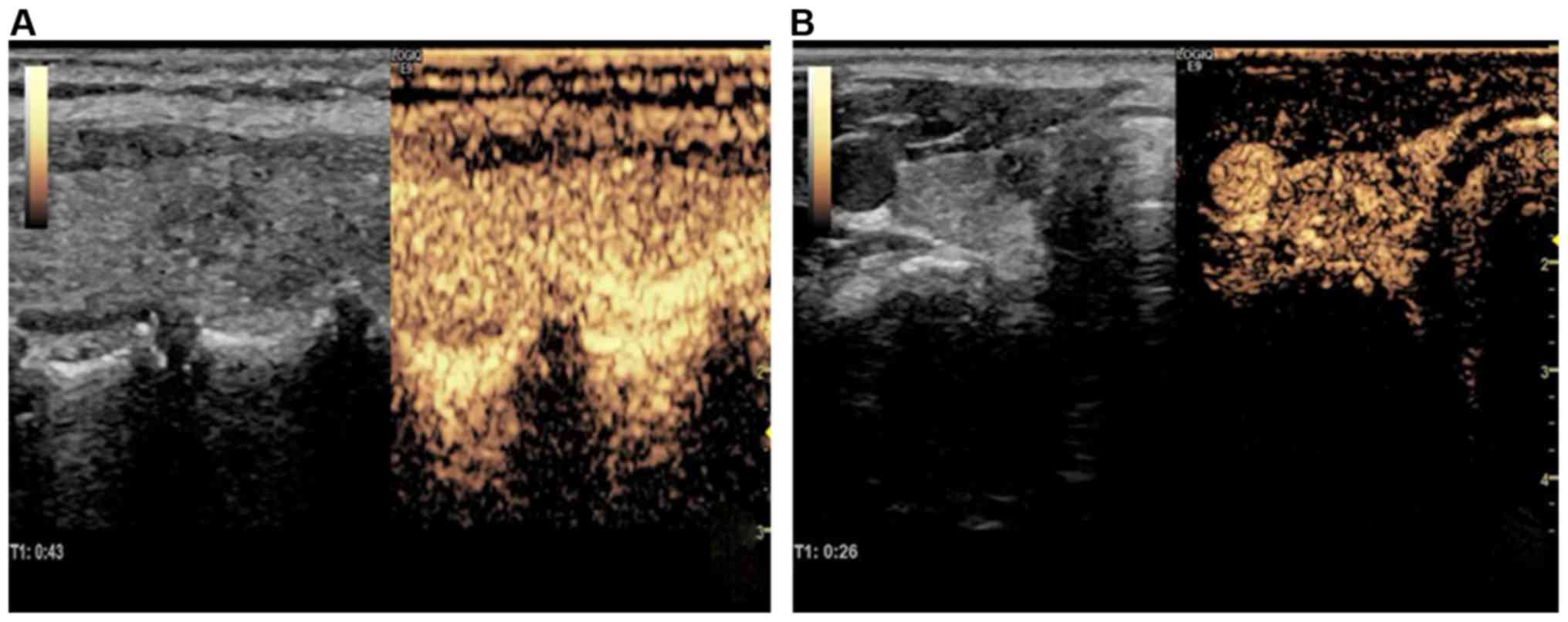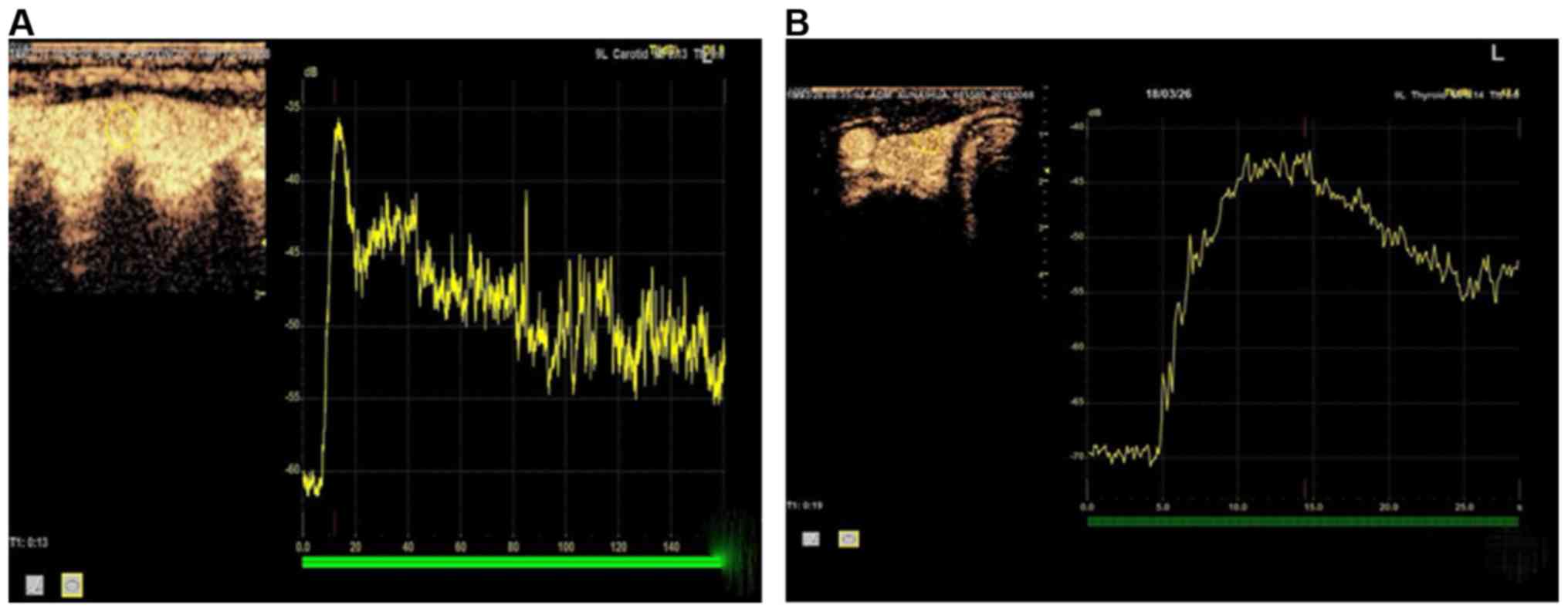|
1
|
Lu Z, Mu Y, Zhu H, Luo Y, Kong Q, Dou J
and Lu J: Clinical value of using ultrasound to assess
calcification patterns in thyroid nodules. World J Surg.
35:122–127. 2011. View Article : Google Scholar : PubMed/NCBI
|
|
2
|
Wang Z, Zhang H, Zhang P, He L and Dong W:
Diagnostic value of ultrasound-detected calcification in thyroid
nodules. Ann Acad Med Singapore. 43:102–106. 2014.PubMed/NCBI
|
|
3
|
Jiang J, Shang X, Zhang H, Ma W, Xu Y,
Zhou Q, Gao Y, Yu S and Qi Y: Correlation between maximum intensity
and microvessel density for differentiation of malignant from
benign thyroid nodules on contrast-enhanced sonography. J
Ultrasound Med. 33:1257–1263. 2014. View Article : Google Scholar : PubMed/NCBI
|
|
4
|
Nemec U, Nemec SF, Novotny C, Weber M,
Czerny C and Krestan CR: Quantitative evaluation of
contrast-enhanced ultrasound after intravenous administration of a
microbubble contrast agent for differentiation of benign and
malignant thyroid nodules: Assessment of diagnostic accuracy. Eur
Radiol. 22:1357–1365. 2012. View Article : Google Scholar : PubMed/NCBI
|
|
5
|
Kim D, Kim DW, Heo YJ, Baek JW, Lee YJ,
Park YM, Baek HJ and Jung SJ: Computed tomography features of
benign and malignant calcified thyroid nodules: a single-center
study. J Comput Assist Tomogr. 41:937–940. 2017. View Article : Google Scholar : PubMed/NCBI
|
|
6
|
Tugendsam C, Petz V, Buchinger W,
Schmoll-Hauer B, Schenk IP, Rudolph K, Krebs M and Zettinig G:
Ultrasound criteria for risk stratification of thyroid nodules in
the previously iodine deficient area of Austria - a single centre,
retrospective analysis. Thyroid Res. 11:32018. View Article : Google Scholar : PubMed/NCBI
|
|
7
|
Ning CP, Ji QL, Fang SB, Wang HQ, Zhong YM
and Niu HT: Distribution patterns of microcalcifications in
suspected thyroid carcinoma: A classification method helpful for
diagnosis. Eur Radiol. 28:2612–2619. 2018. View Article : Google Scholar : PubMed/NCBI
|
|
8
|
Koltin D, O'Gorman CS, Murphy A, Ngan B,
Daneman A, Navarro OM, García C, Atenafu EG, Wasserman JD, Hamilton
J, et al: Pediatric thyroid nodules: ultrasonographic
characteristics and inter-observer variability in prediction of
malignancy. J Pediatr Endocrinol Metab. 29:789–794. 2016.
View Article : Google Scholar : PubMed/NCBI
|
|
9
|
Jiang J, Shang X, Wang H, Xu YB, Gao Y and
Zhou Q: Diagnostic value of contrast-enhanced ultrasound in thyroid
nodules with calcification. Kaohsiung J Med Sci. 31:138–144. 2015.
View Article : Google Scholar : PubMed/NCBI
|
|
10
|
van Sloun RJG, Demi L, Postema AW, Jmch De
La Rosette J, Wijkstra H and Mischi M: Entropy of
ultrasound-contrast-agent velocity fields for angiogenesis imaging
in prostate cancer. IEEE Trans Med Imaging. 36:826–837. 2017.
View Article : Google Scholar : PubMed/NCBI
|
|
11
|
Na DG, Kim DS, Kim SJ, Ryoo JW and Jung
SL: Thyroid nodules with isolated macrocalcification: Malignancy
risk and diagnostic efficacy of fine-needle aspiration and core
needle biopsy. Ultrasonography. 35:212–219. 2016. View Article : Google Scholar : PubMed/NCBI
|
|
12
|
Özemir IA, Bayraktar B, Anılır E, Orhun K,
Eren T, Sağıroğlu J, Ceyran AB, Yiğitbaşı R and Alimoğlu O: The
association of papillary thyroid cancer with microcalcification in
thyroidnodules with indeterminate cytology based on fine-needle
aspiration biopsy. Turk J Med Sci. 46:1719–1723. 2016. View Article : Google Scholar : PubMed/NCBI
|
|
13
|
Majstorov V: Ultrasonographic findings in
patients with benign and malignant thyroid nodules who underwent
ultrasound guided fine needle aspiration cytology. Open Access
Maced J Med Sci. 3:689–693. 2015. View Article : Google Scholar : PubMed/NCBI
|
|
14
|
Khoo ML, Asa SL, Witterick IJ and Freeman
JL: Thyroid calcification and its association with thyroid
carcinoma. Head Neck. 24:651–655. 2002. View Article : Google Scholar : PubMed/NCBI
|
|
15
|
Liu MJ, Men YM, Zhang YL, Zhang YX and Liu
H: Improvement of diagnostic efficiency in distinguishing the
benign and malignant thyroid nodules via conventional ultrasound
combined with ultrasound contrast and elastography. Oncol Lett.
14:867–871. 2017. View Article : Google Scholar : PubMed/NCBI
|
















